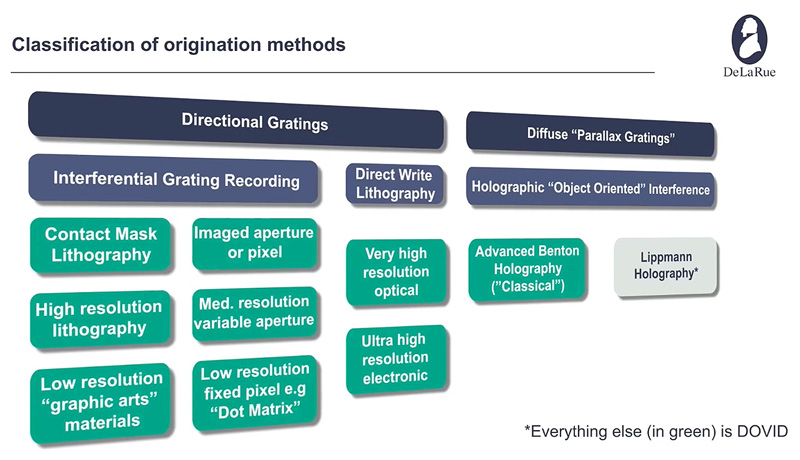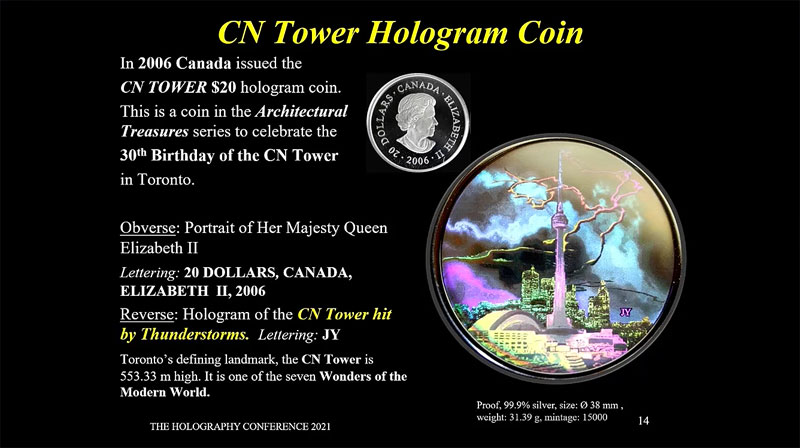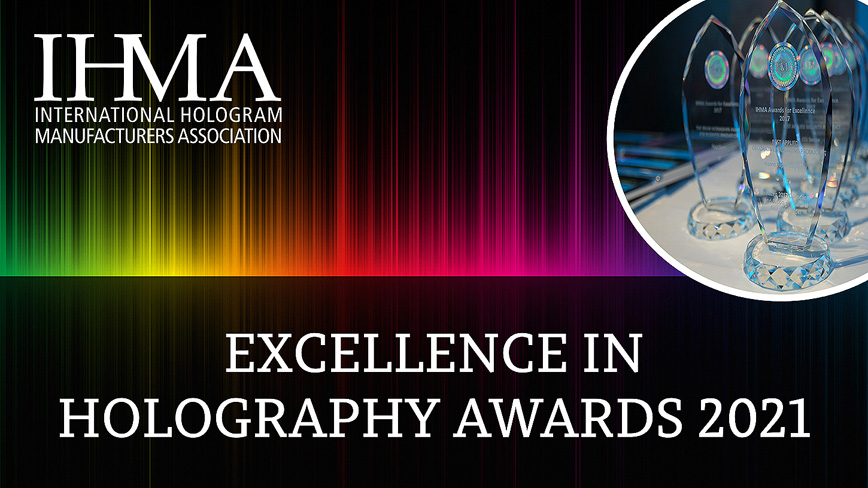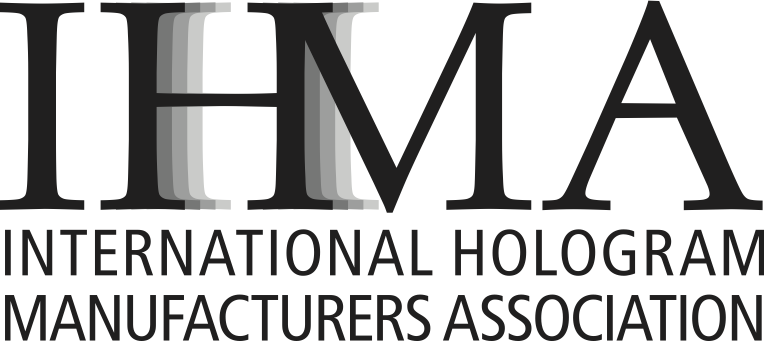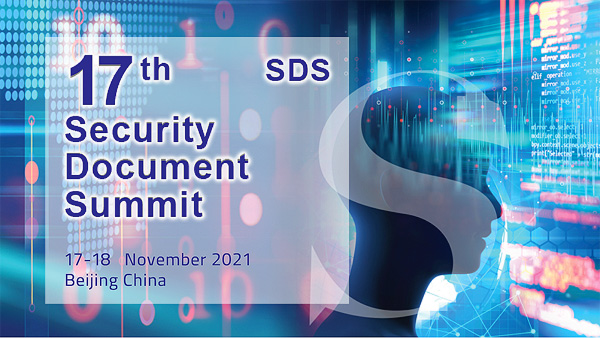2021 Review
The Holography Conference Online 2021 – Trend for Increased Government Attendance Continues
Last year’s The Holography Conference Online (THCO) saw an increase in participation from government officials involved in specifying security features for banknotes, ID cards, driving licences and other documents of value. The trend continued at this year’s event, which took place 17-18 November, with half of all 120 participants coming from central banks and government agencies.
The Holography Conference has traditionally been a forum for hologram suppliers, producers and users to meet and exchange information and experiences. It has also been a place to share and showcase the latest technologies, production techniques and to discuss applications and markets. This year the event was sponsored by The Authentication Solution Providers’ Association (ASPA) and partnered with Holography News®, The International Hologram Manufacturers Association (IHMA) and the 17th Security Document Summit (SDS).
While the conference program reflected the wide range of applications that benefit from holographic technologies, the statistic that 50% of all attendees came from government is testament to the role that holograms and other diffractive optically variable image devices (DOVIDs) have established as the primary first level anti-counterfeit devices.
Attendance
The conference was divided into four thematic sessions to reflect the diversity of applications for holograms in document security, brand protection and packaging enhancement.
High Security Features in Action
Frank van der Horst, researcher and senior policy advisor at the Cash Policy Department of De Nederlandsche Bank, started proceedings in the High Security Features in Action session of the conference with his presentation on ‘It All Starts with Attention’.
The good news for readers of Holography News® is that in Frank’s recent poll of the Dutch public, the hologram was the second-best known feature on euro banknotes (39%), second only to the watermark (75%). In a similar survey in 2017 of features that provide the impression of ‘difficult to counterfeit’, hologram foil features were rated with the highest confidence score. Frank’s ongoing research in the area of security features recognition and trust has some key policy implications for banknote design, most notably that salient elements should be near the security feature, not elsewhere on the note.
Since 2011, Ian Smith from KURZ, has dealt with sales of KINEGRAM foil for banknotes in various regions around the world. His presentation on ‘OVD Foil in Banknote Windows: the Current State of the Art’ was a whistle stop tour through banknotes from across the globe that are protected with the KINEGRAM origination technique encapsulated in a window feature.
Ian started with a description of the Euro Series II, in which the banknotes are made of cotton-based substrate (paper) and in which all bar the two lowest denominations have a window with foil over the top.
In a world first for a conference, Ian presented an animation of the window cutting and laminate stripe application in a one-pass rotary process. The window is cut into the paper with either a die or laser cut, the foil is then applied as a laminate over the window in registration to the height of the banknote. On the reverse of the paper there is a counter-foil applied to equalise the absorption of moisture into the paper.
The images viewable on the front and reverse of the EURO (Ian used the ‘20’ as his example) are distinctive KINEGRAM REVIEW® images, in that the single number ‘20’ on the front is different to the repeated wallpaper pattern of ‘20s’ on the reverse with both cases being right reading.
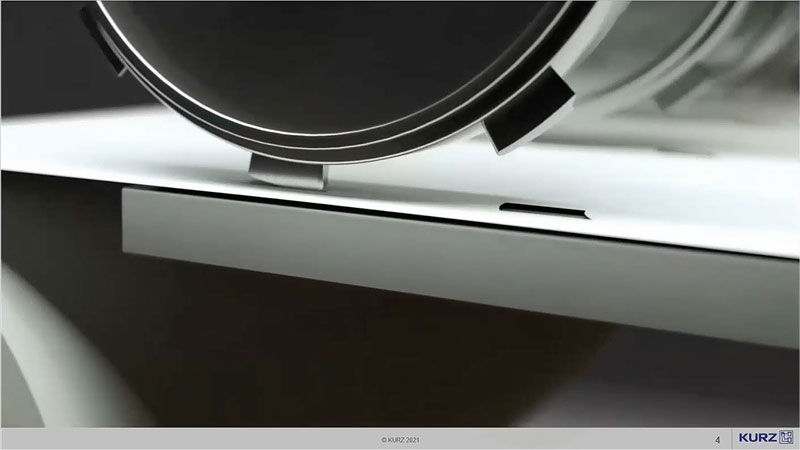
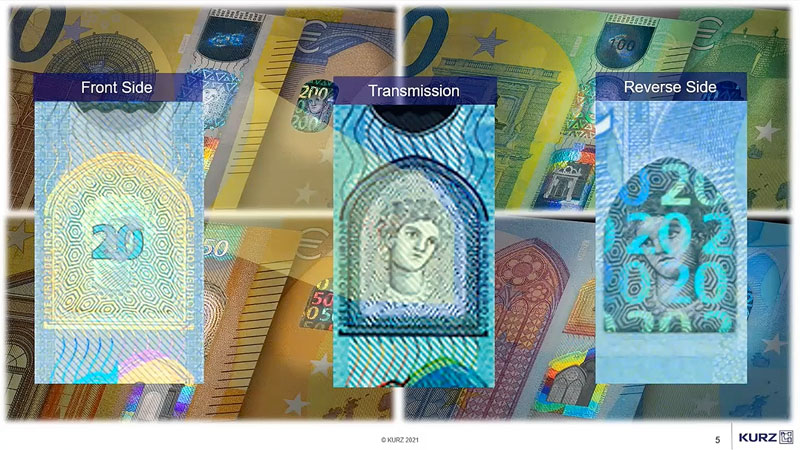
KINEGRAM REVIEW® Stripe over window – Euro series II (©KURZ)
Ian continued the theme of KINEGRAM variations that include the KINEGRAM HDM High-Definition Metallisation stripe over window on the Polish zloty, the KINEGRAM Applied Path Label (APL) on a house note from Orell Füssli and KINEGRAM COLORS® APL with KINEGRAM ZERO.ZERO on a note produced by the Hungarian Banknote Printing Company.
All of the above are paper banknotes, but the majority of banknotes with window features are produced on polymer, a technology which led the way in the incorporation of apertures both as intrinsic features and carriers of different optical effects.
Ian went on to catalogue what he believed to be all of the polymer banknotes in circulation that have a foil feature in the window. The job of making a window in a polymer, rather than a paper. note is made easier by the fact that the substrate starts off transparent so that the window is actually a hold-back mask of the opacity ink applied to the remainder of the note.
The presentation also delved into the types of metallisation that KURZ uses to achieve a range of minimum line widths and placement tolerances with the KINEGRAM ZERO.ZERO® rated with +/- 0.0mm tolerance between the metal and the diffractive feature.
Ian concluded his wide-reaching review by illustrating the theme of his presentation that, despite the depth of engineering and technical knowhow that go into making OVD foil on banknote windows, the objective of the end result is to provide unambiguous and easy to recognise features for the public to read. The presentation ended with a Spanish language public awareness video from the Central Bank of Costa Rica, which has recently converted its whole series to polymer – the message for which focuses around the mantra of Toque, Mire, Gire (ie. Feel, Look, Tilt).
In the third paper of the session, Nuno Gonçalves from the Imprensa Nacional Casa da Moeda (INCM), the Portuguese state printer and mint, explored the challenges in the creation of a mobile validation system of holograms using computer vision. Nuno’s presentation noted that new possibilities for brand protection and anti-counterfeiting are being opened up by hologram validation using computer vision on smartphones.
One of the first results of this work is a strategic alliance that he announced between INCM and UK brand protection specialist OpSec to support governments in implementing high security tax stamp solutions.
Concluding the session’s presentations, Alan Newman – Currency Product Director at De La Rue – argued that, of all the security features for banknotes, holograms are the most misunderstood. Alan’s paper explained how today’s high security banknote-grade holograms are a world apart from the holograms that appeared on banknotes in the 1980s. He set out how holograms differ from other anti-counterfeiting technologies and how polymer banknotes in particular have played a key role in unlocking new holographic effects.
Physical to Digital
The second session of the conference, titled ‘From Physical to Digital – Authentication on the Move’ looked at some strong emerging technology factors, like smart serialisation and ubiquitous communications, which are changing the way that holograms are integrated into brand protection and supply chain management.

ASPA Report
Manoj Kochar has a background in both holography and authentication – he is a past president of the ASPA, India and the current ASPA representative on the IHMA board. ASPA’s report on ‘The State of Counterfeiting in India, 2021’ formed the starting point for Manoj’s paper on the ‘Evolution of Phygital Hologram in India – Current Overview’.
The term ‘phygital’ is becoming an accepted shorthand for features based on or combining physical and digital technology, and Manoj presented several use cases where multiple formats of physical and digital security measures combine to bring heightened protection and convenience to the consumer.
Manoj also highlighted the role that is being played by policy makers in government to galvanise the transition from physical to digital security, most notably with India’s National ID card – the Aadhaar card – which is a physical record of what is essentially an electronic assertion of identity. The physical card comes in credit card format, has a host of printed security features, a hot-stamped hologram and QR code.
Following Manoj, Peter Scheir founder of AD 2000 Inc and AuthentiBrand Inc, explained how he quickly recognised the need for anti-counterfeiting protection for the burgeoning cannabis market in the US after he moved to San Diego in 2017.
Peter’s paper, ‘Cannabis – Thwarting Counterfeit in the Wild West of Markets’ set out why the regulatory and legal framework for production and sales of cannabis are similar to the sale of alcohol at the end of prohibition, although cannabis is still federally illegal. Peter stressed the importance that all legitimate brands need to show their customers suppliers and retailers that the packages are real and contain authentic products.
The third presentation in the session came from Neal Skura, Director of Canadian company Nanotech. Neal’s starting premise was that, to be effective, overt optical security must be both easy to authenticate and difficult to simulate. He presented a toolkit of innovative nano-optic based visual effects to combat counterfeiting activity. His discussion also examined industry trends as well as recent examples of Nanotech LiveOptik™ successfully protecting the world’s largest sporting events.
When asked about what effect the recent acquisition of Nanotech by nanocomposites company Meta Materials might have, Neal was relaxed in saying that he expects a continuing emphasis on innovation that will bring new products to market.
The final presentation of Day 1 of the conference was an update from Linda Law on the progress of the Virtual Museum of Holography in the US. Linda, who is founder of the virtual museum, has a long history of working in the field of holography as an artist, teacher, curator and digital content creator. Through her work at the virtual museum, she is establishing a new way of presenting holograms to the world using Light Field Technology.
Novel Materials, Techniques and Applications
The second day of the conference started with a session on ‘Novel Materials, Techniques and Applications’. Despite being a largely optical recording technology, holography has always depended on high resolution recording materials and good quality mass production and converting to ensure fidelity in the finished product.
In Jochen Kirsch’s presentation ‘Quality Hanging by a Thread. Mastering the Challenge of Thread Slitting Inspection’, ISRA VISION’s Sales Director of the Security business unit emphasised that thread inspection in the slitter is the last and most important quality gate for security threads, with or without holographic or diffractive security features. Unfortunately, Jochen went on, existing automated optical inspection solutions for thread slitters have left a lot to be desired. The paper discussed their shortcomings and proposed a new approach.
The theme of novel materials and applications was further developed by Dominique Collé from Heidelberg Instruments Mikrotechnik (Germany) in his paper ‘Maskless Lithography Technologies Applied to Holographic Effects’, which described how a digital light modulator can be used to directly and quickly write a binary or relief pattern onto a resist coated substrate, resulting in a sturcutred surface that diffracts light in a predetermined manner to create colourful optical effects.
Libor Šustr from Optaglio (Czech Republic) continued the theme in his presentation ‘Ultimate Holographic Data Protection’, in which he highlighted the company’s technologies to protect the data on polycarbonate documents such as ID cards or the data pages of passports.
In his paper ‘New Opportunities for Holographic Coins’, Dr Hans Bjelkhagen, author of ‘Holography and Philately – Postage Stamps with Holograms’ turned his attention not to postage stamps but to coins. In his chronological exploration of the minting of metals with surface relief holograms to produce some really striking visual effects, Hans catalogued many of the holographic coins that have been produced – mostly for collectors or very limited circulation. One example of the CN Tower Hologram Coin depicts an awe-inspiring scene of the CN Tower in Toronto being struck by lightning.
The final session of the conference took a forward look into the continuing development of the technology and was witness to the incredible diversity within the holographic community.
Representing the field of academic research, Daniel Blackmore and Oliver Peacock, both PhD students from De Montfort University (DMU Leicester, UK) led us through their research into holographic colour, depth and movement.
Daniel’s work on true colour analogue holography complemented Oliver’s work on the different ways that artists and scientists create depth in holograms. They both have some time to develop their work at DMU and seemed encouraged by the advice and support that came from the conference audience during the Q&A session.
The conference was thankful to Dr WeiWei Zhang’s for staying up late (by now it was 10pm Beijing time, from where WeiWei was joining) to deliver his paper on ‘Dynamic and Full-Colour Projective Imaging Technology’.

ColorNova® (©ZSST)
Dr Zhang’s work at the Zhongchao Special Security Technology Company (ZSST) focuses on optical security effects and his paper introduced two novel projection imaging techniques: ColorPro™ technology is based on the reflection and focus of optical microstructures while ColorNova® is viewed in transmission with, for example, the torch from a mobile phone acting as the light source
It seemed fitting that the concluding presentation of the session and the conference was on ‘Latest Developments in the Hologram Image Register (HIR)’.
Dr Paul Dunn, currently Director of Technology Innovation at OpSec Security and Chair of the IHMA, briefed the audience, many of whom are members of the association, on the unique nature of the HIR and how it is rightly perceived as the ‘jewel in the crown’ of the IHMA services. It is now an integral part of compliance with the ISO 14298 standard.
Paul highlighted that, as the industry evolves, the HIR needed to keep pace with the needs of the membership and that he would announce further updates to the register in the coming weeks.
Holography News® will be covering a selection of the individual presentations in more detail in future issues.
Following the formal sessions of the conference, the mood switched to celebration as the winners of the IHMA Awards for Excellence in Holography 2021 were announced. Details of the winners in the five categories, as well as the ‘People’s Choice’, can be found on the IHMA Awards website.
After the decision to run The Holography Conference in an online format in 2020 for reasons of COVID travel restrictions, the decision to keep the online format for THCO 2021 was made for functional and aesthetic ones. The hard work of the technical staff behind the scenes provided an excellent format with engaging graphics and layouts to showcase the continuing developments in holography.
Attendees
Alan Hodgson Consulting Ltd
United Kingdom
Algazo for Import and Export
Jordan
All4Labels Smart + Secure GmbH former Hologram Company RAKO GmbH
Germany
ASPA
India
Authentibrand
USA
Banca d’Italia
Italy
Banco Central do Brasil
Brazil
Banco de España
Spain
Banco de Portugal
Portugal
Bangladesh Bank
Bangladesh
Bank of Canada
Canada
Bank of Mongolia
Mongolia
Beijing Jinchen CVIC Security Printing Co.,Ltd
China
Bundeskriminalamt Germany
Germany
Canada Border Services Agency
Canada
Cayman Islands Monetary Authority
Cayman Islands
Central Bank of Armenia
Armenia
Central Bank of Kuwait
Kuwait
Central Bank of Malta
Malta
Central Bank of Somalia
Somalia
Central Bank of Turkey, Banknote Printing Works
Turkey
Central Bank of Uruguay
Uruguay
Centre for Development of Imaging Technology (C-DIT), Govt. of Kerala
India
China Banknote Security Printing Technology Research Institute Co,LTD.
China
Computer Holography Centre Ltd
Russian Federation
Croatian National Bank
Croatia
De La Rue
United Kingdom
De Montfort University
United Kingdom
DNB – De Nederlandsche Bank
Netherlands
Eesti Pank
Estonia
Emeteq Technology Co.,Ltd.
China
European Central Bank
Germany
Federale politie Scheepvaartpolitie
Belgium
Fedpol
Switzerland
Forgery & counterfeiting dep., Ministry of Justice, Egypt.
Egypt
Hansholo Consulting Ltd
United Kingdom
Hazen Paper Company
USA
Heidelberg Instruments Mikrotechnik
Germany
Holoflex Ltd.
India
Holographic Security Marking Systems P Limited
India
Hueck Folien
Austria
IHMA
United Kingdom
INCM – Portuguese Mint and Official Printing Office
Portugal
Intergraf a.i.s.b.l.
Belgium
International Currency Association
United Kingdom
ISRA VISION
Germany
ITW Specialty Films
USA
Koenig & Bauer Banknote Solutions
Switzerland
LEONHARD KURZ Stiftung & Co. KG
Germany
Linda Law Holographics
United Kingdom
Mint Directors Conference
Australia
Mitsubishi Polyester Film GmbH
Germany
nanografix
USA
Nanotech
Canada
Narodowy Bank Polski
Poland
National Bank of Belgium
Belgium
Nationalt ID Center
Denmark
NIBAF
Pakistan
OpSec
United Kingdom
Optaglio
Czech Republic
Papierfabrik Louisenthal GmbH
Germany
Police Presidium of the Czech Republic
Czech Republic
PT. Pura Barutama
Indonesia
Reconnaissance International
United Kingdom
Research Institute of Information Technology of National Immigration Administration
China
Shandong Taibao Information Technology Group Co.,LTD
China
Shanghai Hongdun Anti-Counterfeit Material Co.,Ltd.
China
Shenzhen Holoart High Technology Company Limited
China
Shriram Veritech Solutions Pvt Limited
India
South African Reserve Bank
South Africa
SURYS
France
TECHSUN GROUP
China
Tianjin GsighT Technology Co.,Ltd
China
United States Federal Reserve Board
USA
US Homeland Security Investigations Forensic Laboratory
USA
Valoridicarta S.p.A.
Italy
Water Mark Publishing House
Russian Federation
WUHAN HGIMAGE TECHNOLOGY & DEVELOPMENT CO.,Ltd.
China
XRD nano Limited
United Kingdom
Zhongchao Special Security Technology Co.,Ltd., subsidiary of China Banknote Printing and Minting Co
China
For attendees only – password was provided by our event team.
Wednesday 17 November 2021
11:00 – Opening Film & Conference Welcome
Session 1 – Protection, Prevention, Perception – High Security Features in Action
11:20
OVD Foil in Banknote Windows: the Current State of the Art
Ian Smith
LEONHARD KURZ Stiftung & Co. KG (Germany)
11:35
Challenges in the Creation of a Mobile Validation System of Holograms Using Computer Vision
Nuno Gonçalves
Portuguese Mint and Official Printing Office (Portugal)
15 minutes for Q&A
12:30 – Break – Awards Intro and Submissions
13:00 – Intro Session 2
Session 2 – From Physical to Digital – Authentication on the Move
13:20
CANNABIS – Thwarting Counterfeit in the Wild West of Markets!
Peter Scheir
AuthentiBrand (United States)
13:37
LiveOptik™ – Combatting Counterfeits with A Toolkit of Authentication Effects
Neal Skura
Nanotech (Canada)
13:50
The Virtual World of Holography, Where Next?
Linda Law
The Virtual Museum of Holography (United States)
15 minutes for Q&A
14:30 Wrap-Up Day 1
Thursday 18 November 2021
11:00 – Opening Film & Day 2 Welcome
Session 3 – Novel Materials, Techniques and Applications
11:05
Quality Hanging by a ThreadMastering the Challenges of Thread Slitting Inspection
Jochen Kirsch
ISRA VISION
11:20
Maskless Lithography Technologies Applied to Holographic Effects
Dominique Collé
Heidelberg Instruments Mikrotechnik (Germany)
15 minutes for Q&A
12:30 – Break – Awards Intro and Submissions
13:00 – Intro Session 4
Session 4 – Continuing Development for a Brighter Future
15 minutes for Q&A
14:30 Awards Ceremony
14:50 Conference Closing
Holography Awards Reflect Industry’s Growth and Success Despite Difficult Challenges
The winners of this year’s Excellence in Holography awards reflect a global industry that continues to expand, innovate and find new markets, according to organisers International Hologram Manufacturers Association (IHMA.
The awards mark the pinnacle of success for those who have been involved at the forefront of developing innovative or commercially viable hologram products or techniques over the last 12 months, recognising unparalleled sector achievement during the difficult and challenging times caused by Covid.
The 2021 awards saw Krypten Research and Production Company scoop the coveted ‘Innovation in Holographic Technology’ award for its 3D-GRAM® CONTRUST Security Patch for the 100/50 Nobelists House Note.
The judges were particularly impressed by the intensive work of Krypten to create a security patch with innovative photopolymer-based security features. In particular, the ‘striking and catchy’ element with a simple and unambiguous identification, enabling the patch to be applied both on paper and polymer-based banknotes.
The judges also recognised Surys in the ‘Best Origination’ category for its Gold Fish – a unique piece featuring the first application of Plasmogram™ Reverso on a banknote. Other category winners were:
‘Best Applied Decorative/Packaging Product’ – Hazen Paper Company’s 2021 Basketball Hall of Fame Enshrinement Yearbook
‘Best Applied Security Product’ – Louisenthal’s Azerbaijan 50 Manat with a RollingStar LEAD Mix foil stripe
‘Best Display or Emerging Technology Application of Holography’ – Immersive Content Display Center’s Yuri Denisyuk full-color CHIMERA Holographic portrait
‘People’s Choice’ – Nanotech Security Corp. UEFA Euro Tickets
Involving industry opinion formers, suppliers, manufacturers and end-users from around the world, the awards were again held online (17-18 November). Dr Paul Dunn, chair of the IHMA, commended the standard of entries as extremely high and eye-catching, contributing to a ‘confident and strong’ industry that continues to evolve, innovate and secure new markets and exciting applications.
He added: “Once again, these awards celebrate the very best in holographic achievement and the many remarkable innovations the industry introduces each year. Creativity, flair and design excellence have again shone in the 2021 entries, reflecting how our industry continues to push the boundaries forward both technically and commercially.”



